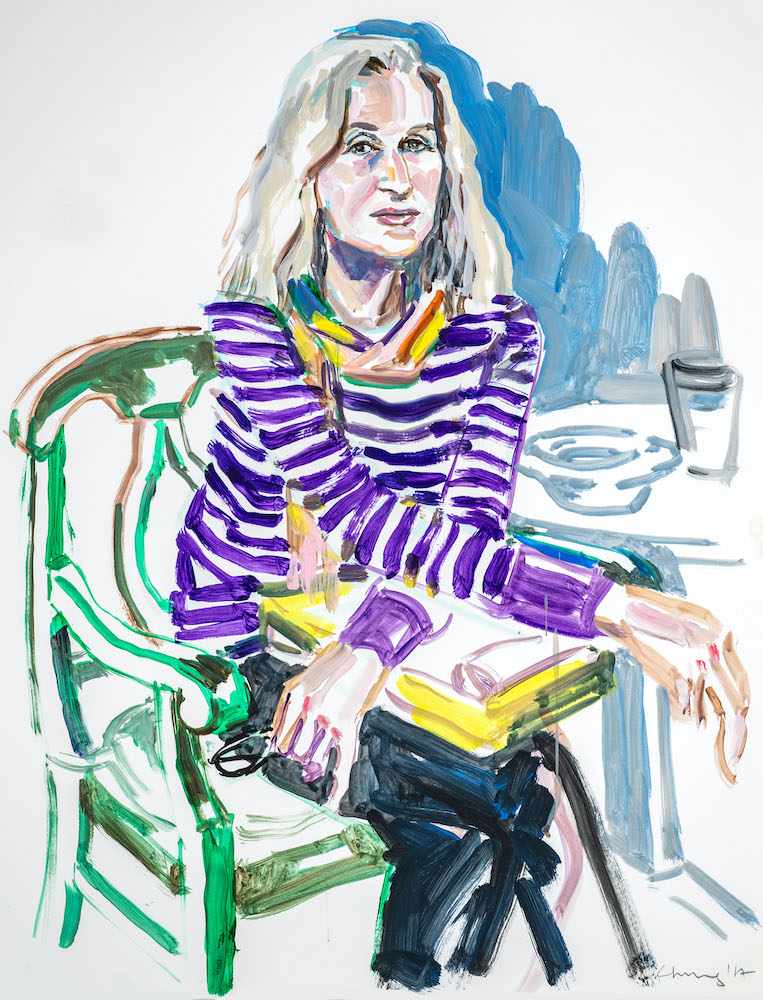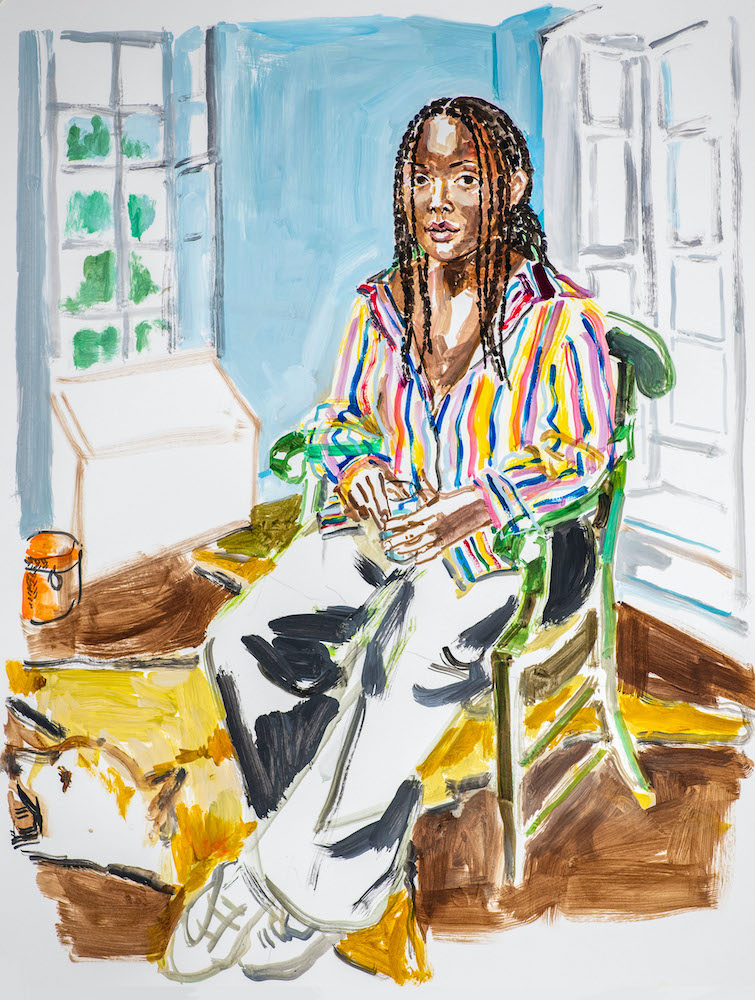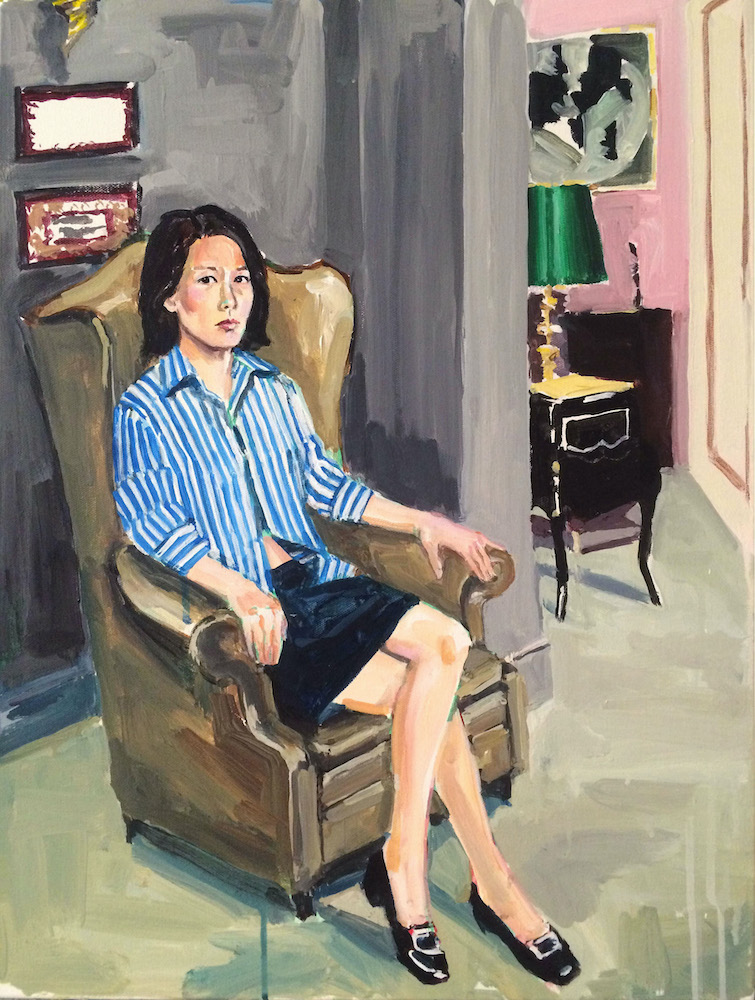The afternoon we agree to meet for a quick Q&A over drinks, Helen Chung arrives at the restaurant slightly late (though not much later than me)—fittingly enough, from a commissioned portrait sitting. Engaged by the process, conversation and the resulting portrait itself, the subject has kept her somewhat longer than originally anticipated—commissioning a second portrait on the spot.
Portrait painting can be a complicated business—complicated by the artist’s knowledge, acquaintance or relationship with the subject (and vice-versa), the subtle push and pull of the process itself, the subject’s own self-knowledge or awareness, or sheer vanity. A bit of choreography may be involved (a shift of positioning or placement); art direction may be tweaked (something of a specialty for this artist). Conversation enlivens the process, but may also prolong and complicate it: mouth, lips, cheeks, jaw, eyes move—and the face changes. It is a social process and Helen rolls with it, but she is adroit at giving direction or asserting control when necessary.
Full disclosure: I have known Helen for a number of years and we are friendly. And yes—she has painted my portrait (two in one sitting—both excellent likenesses, each revealing a distinctive mood and aspect). Most people in the LA arts community are aware that the core of her practice is conceptual and frequently quite abstract. But she is known for her portraiture: she has painted more than 100 portraits over the last six or seven years, and between 60 and 70 of them are people well known in the LA art world.
Helen orders a chamomile-mint tea and we don’t quite get down to business—since (as if I were sitting for a portrait) we chat about everything. We start with the portrait she just finished:
CHUNG: At first I thought this one was coming out more abstract; but then it turns out that he thinks it looks more like himself. And that’s always what happens. What I think is less like them, they often think, “No—you really captured me here even more!”
As I was telling [her subject], I’ve been reading a lot of Elizabeth Bishop lately, and what I realized appealed to me so much is that she repeats herself from one line or stanza to the next, changing something a little, then changing it again; and then changing something else. She’s constantly restating or readjusting the idea with something just slightly different.
And this way of restating the idea is very appealing to me—because when I do these portraits, I’m very aware that I’m going to correct the mark I just made, but I’ll make it anyway. And then I’ll go in there and deliberately make another mark that I think—ha!—that’s also going to be altered. But I like that alteration constantly happening until it just feels right—when all the different alterations feel right just staying there. It’s as if I were subconsciously applying her method of observing and reimagining things, and then setting down what she imagined in the lines of her poem.
I think there’s imagining in Bishop’s process that connects with the intuitive way I approach my subject. And when I do my abstract work, it’s exactly the same. There are certainly differences, but it’s a similar process to build something up, knowing it might be something I have to correct or follow-up on; but I have to keep going through it.
I’m not interested in just re-narrating everything people see and already know about, the typical portraiture—people sitting a certain way in front of us, stuff in the studio background or a photo reference, just capturing life like that. It’s just not enough for me.
ARTILLERY: As you’re making a mark, you’re conscious of what immediately preceded where you’re at, while thinking ahead to the next mark—and sort of merging the two or three positions or marks. There’s a constant oscillation—which turns out to be one way to an excellent likeness. I think a lot of us relate to that simply as a matter of being. You’re doing one thing, but thinking a little bit about something else, the next thing.
I’m always thinking of something else—three other things!”

Helen Chung, Ezrha, 2017. Courtesy of the artist. [Portrait of the author of this story].
And if you’re writing, sometimes you’re drilling down into the word or sentence, but at the same time thinking a bit ahead and conscious of how the other part of the sentence or paragraph fits. I think I make myself slightly mad doing that. But you’re not slow about it; you execute these things pretty rapidly. You keep your brushes moving, and you get it done.
I think you need to do that. It’s what people are used to, and then they start talking to me—and it makes it easier for me if they don’t move too much. While they’re talking with me, they’ll sometimes drift off par hasard, looking slightly away, and I’ll get a nice three-quarter view. People can be very insecure about their noses. But I like them better when they’re slightly three-quarters and show the nose. But I like their eyes to turn to me.
Funny that we call that sort of look “abstracted”—which has something to do with the dynamic of the process, having to do with being self-conscious about having someone focusing on one’s likeness, but also distracted by one’s thoughts—and then you’re conversing on top of it.
It can get complicated. Some people, I probably shouldn’t encourage to talk. Something gets into their head and they just can’t stop talking. I had one subject I found slightly odd-looking—almost like a Martian, but kind of beautiful. But it was like ten parts of her body were in motion as she talked. And she could not stop talking.
But then you always engage people—you have to.
I do! I was going to say that I don’t necessarily have to pay that much attention, because I’m really focused on my drawing first and foremost. And when I engage them, they reveal stuff about themselves that goes into the painting.
And some of that comes across in portraits of subjects like “G”—who’s a talker, a writer, a thinker.
All of that. I think it’s something unique to my practice because I want to capture something of their essence; it would be hard for me to do that if they were just sitting there …I’ve tried.
“G” started to ask me, “Do you want me to do something different?” And I said, “No—stay where you are. If I want to change your hands, I’ll change them myself.” And he says “How?” “In my drawing, not with you.” I already know what his hand looks like in every position. So if it’s not the right shape I’m looking at, I can change it to another—just in my drawing.
I feel like I’m still allowing myself to make mistakes—which I actually embrace. Outside the contemporary art world, you can see some extremely tight rendering made for the sake of a kind of realism that takes no chances; and that’s why their work looks dead. You’ve got to take the chance to let the errors happen because that’s when it comes alive.
We’re all human and I’m trying to capture it in real time. And in real time there’s going to be some weird gestures or hand movements or conditions that you want to acknowledge—instead of changing the person.
I’ve told you about how I love Brice Marden—and I was just thinking about how he always erases about 70 percent of his markings—making a mark and then really thinking about that, and then seeing how much can be removed and that erasure is part of the painting. I guess I paint over rather than erase, but I like to be able to see what I covered over. So that the little struggle is visible, and also adds texture to an otherwise fairly effortless piece of work.

Helen Chung, Makayla, 2019. Courtesy of the artist.
But for the most part, a gesture, positioning, placement are to one extent or another a function of your subject’s personality, manner and demeanor, and that enters into the portrait chemistry. That’s a real art.
I won’t change the character of the portrait.
We’ve talked before about how your portrait-painting, as a routine part of your art practice, began as “lunch portraits”—made in the spirit of Frank O’Hara’s Lunch Poems. How have the portraits evolved since those first portraits of your “lunch visitors”—your pals, other artists and random sitters?
In the beginning I was simply portraying what I saw in front of me. I wanted to be pretty accurate. But as I began doing more and more of them, I realized I could take more liberties—changing the positions of their hands, manipulating stuff in the background. Hands are always important. They speak for a person. Two years into this process, my imagination was much more integral to making these portraits. People are usually chatting on [during a sitting] and what they tell me can spin off another image for me. It’s not always directly related to the subject, but if I have an idea of something that will transport them to another place, I’ll ask them.
I put Thomas Linder in a kind of wooden cottage that seemed like it might belong to his grandmother—but then he doesn’t have that kind of a grandmother. I did a painting of a subject who was tired—he had his sunglasses on and was constantly looking at his phone—I couldn’t make eye contact with him. So I put him in Julian Schnabel’s apartment—with a big Schnabel painting behind him.
But I thought eye contact was critical for you.
I made an exception—I work with whatever I’ve got. He looked adorable and he wanted to sit for me. So I said, “Let’s do it.


